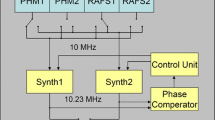Abstract
Recent studies have shown the capabilities of Global Positioning System (GPS) carrier phases for frequency transfer based on the observations from geodetic GPS receivers driven by stable atomic clocks. This kind of receiver configuration is the kind primarily used within the framework of the International GPS Service (IGS). The International GPS Service/Bureau International des Poids et Mesures (IGS/BIPM) pilot project aims at taking advantage of these GPS receivers to enlarge the network of Time Laboratories contributing to the realization of the International Atomic Time (TAI).
In this article, we outline the theory necessary to describe the abilities and limitations of time and frequency transfer using the GPS code and carrier phase observations. We report on several onsite tests and evaluate the present setup of our 12-channel IGS receiver (BRUS), which uses a hydrogen maser as an external frequency reference, to contribute to the IGS/BIPM pilot project.
In the initial experimental setup, the receivers had a common external frequency reference; in the second setup, separate external frequency references were used. Independent external clock monitoring provided the necessary information to validate the results. Using two receivers with a common frequency reference and connected to the same antenna, a zero baseline, we were able to use the carrier phase data to derive a frequency stability of 6 × 10−16 for averaging times of one day. The main limitation in the technique originates from small ambient temperature variations of a few degrees Celsius. While these temperature variations have no effect on the functioning of the GPS receiver within the IGS network, they reduce the capacities of the frequency transfer results based on the carrier phase data. We demonstrate that the synchronization offset at the initial measurement epoch can be estimated from a combined use of the code and carrier phase observations. In our test, the discontinuity between two consecutive days was about 140 ps. © 1999 John Wiley & Sons, Inc.
Similar content being viewed by others
Author information
Authors and Affiliations
Rights and permissions
About this article
Cite this article
Bruyninx, C., Defraigne, P. & Sleewaegen, JM. Time and Frequency Transfer Using GPS Codes and Carrier Phases: Onsite Experiments. GPS Solutions 3, 1–10 (1999). https://doi.org/10.1007/PL00012786
Published:
Issue Date:
DOI: https://doi.org/10.1007/PL00012786




